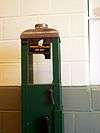Fare
A fare is the fee paid by a passenger for use of a public transport system: rail, bus, taxi, etc. In the case of air transport, the term airfare is often used.
Fare structure is the system set up to determine how much is to be paid by various passengers using a transit vehicle at any given time.
A linked trip is a trip from the origin to the destination on the transit system. Even if a passenger must make several transfers during a journey, the trip is counted as one linked trip on the asystem.
Uses
The fare paid is a contribution to the operational costs of the transport system involved, either partial (as is frequently the case with publicly supported systems) or total. The portion of operating costs covered by fares - the farebox recovery ratio - typically varies from 30%-60% in North America and Europe, with some rail systems in Asia over 100%.
The rules regarding how and when fares are to be paid and for how long they remain valid are many and varied. Where the fare can be generally be predicted in advance (such as fixed fare systems) fare is usually collected in advance; this is the usual practice of rail and bus systems, who usually require the payment of fares on or before boarding. In the case of taxis and other vehicles for hire, (where the total fare will not be known until the trip is completed) payment is normally made at the end of the ride. Some systems use a hybrid of both, such as a rail system which requires prepayment of the minimum fare in advance, and collecting amounts above the minimum (if the net cost of the trip exceeds the minimum fare) at the end of the trip.
Some systems allow free transfers: that is to say that a single payment permits travel within a particular geographical zone or time period. Such an arrangement is helpful for people who need to transfer from one route to another in order to reach their destination. Sometimes transfers are valid in one direction only, requiring a new fare to be paid for the return trip.
Penalty fares are fares issued for passengers without valid tickets; standard fare is a term with similar meaning. In the United Kingdom, certain Train Operating Companies, such as South West Trains and Southern, have Revenue Protection Inspectors who can issue penalty fares to passengers who travel without a valid ticket. This is currently a minimum of £20 or twice the single fare for the journey made. In Canada, the Toronto Transit Commission charges $500 for people evading the $3 fare.
Farebox


A device used to collect fares and tickets on streetcars, trains and buses upon entry, replacing the need for a separate conductor. Nearly all major metropolitan transit agencies in the United States and Canada use a farebox to collect or validate fare payment. The first farebox was invented by Tom Loftin Johnson in 1880[1] and was used on streetcars built by the St. Louis Car Company. Early models would catch coins and then sort them once the fare was accepted or "rung up". Later models after World War II had a counting function that would allow the fares to be added together so that a total per shift could be maintained by the transit revenue department.
Fareboxes did not change again until around 1984, when fares in many larger cities reached $1.00 and the first dollar bill accepting farebox was put into service. In 2006, new fareboxes had the capability of accepting cash, credit, or smartcard transactions, and issuing day passes and transfers for riders.
See also
| Wikimedia Commons has media related to Fareboxes. |